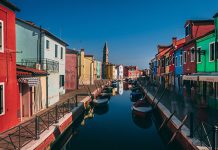If you were asked which country to visit as a tourist, you (as well as many others!) would hardly name Burkina Faso. But in the very center of this country, not far from the sun-scorched savannah, there is a village that is considered to be a pearl of African culture and architecture. It is called Tiébélé and really worth a visit! Kassena people settled here in the 15th century, becoming the oldest ethnic group in Burkina Faso.

The houses in the village are made of clay. What makes them so special? They’re decorated with different patterns and colors that create a hypnotic play of lines.

Photo: Maarten van der Bent/flickr (https://creativecommons.org/licenses/by-sa/2.0/)


If we talk about the “royal palace” then in Burkina Faso it looks completely different to those we used to see and imagine. It is made of bricks and clay as well, decorated with geometric patterns and covered with leaves, like all other houses. The only thing that sets it apart is the door, which for security reasons is smaller than the other houses have.

Photo: Maarten van der Bent/flickr (https://creativecommons.org/licenses/by-sa/2.0/)

Photo: Maarten van der Bent/flickr (https://creativecommons.org/licenses/by-sa/2.0/)
To keep its traditions and avoid exploitation, Tiébélé remained an isolated village for a long time. And even today, locals are very prudent in accepting strangers, although they understand that tourism can improve their economic situation.

Photo: Maarten van der Bent/flickr (https://creativecommons.org/licenses/by-sa/2.0/)

Photo: Maarten van der Bent/flickr (https://creativecommons.org/licenses/by-sa/2.0/)



Photo: By c.hug [CC BY-SA 2.0 (https://creativecommons.org/licenses/by-sa/2.0)], via Wikimedia Commons


Although this village deserves to be famous and admired, one still want to believe that its ethnic and cultural characteristics will remain intact, and the country itself will not turn into a tourist base over time.




















